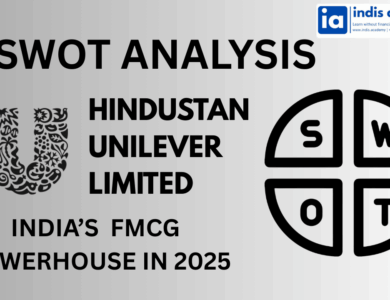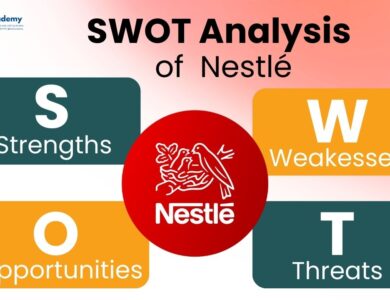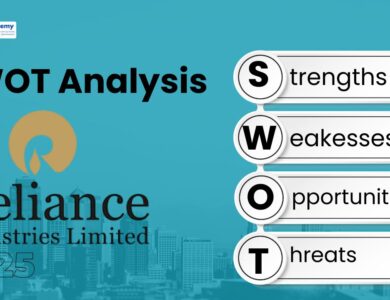SWOT Analysis of Flipkart (2025): Strengths, Weaknesses & E-Commerce Strategy in India
Explore the detailed SWOT analysis of Flipkart in 2025. Discover how India's e-commerce giant is navigating growth, competition, and digital disruption in a rapidly evolving online retail market.

When we talk about India’s e-commerce revolution, one name that instantly comes to mind is Flipkart. What started as an online bookstore in 2007 has today become a multi-billion-dollar digital marketplace catering to everything from smartphones to fashion to groceries.
But in 2025, the Indian e-commerce landscape is fiercely competitive and fast-evolving. With the rise of quick commerce, D2C brands, regional players, and regulatory changes, Flipkart must do more than offer discounts—it must innovate, expand, and sustain profitability.
In this blog, we dive deep into a strategic SWOT analysis of Flipkart, examining its Strengths, Weaknesses, Opportunities, and Threats. Whether you’re a startup founder, digital strategist, MBA student, or just someone curious about India’s online retail game—this article will help you understand where Flipkart truly stands in 2025.
Let’s begin with a quick overview of the company and its ecosystem.
Also read: Complete SWOT Analysis of Zomato – How It Dominates the Food Delivery Market
Learn AI & Digital Marketing,
Pay Fees After Placement
- ✅ Minimal Admission Fees
- ✅ No Loan or Income Sharing Agreement
- ✅ 100% Placement Support
- ✅ ISO & Govt Registered Certificate
- ✅ Practical 3+1 Months Duration
Get a free counseling call. We’ll guide you through learning, certification, and job placement.
Request a Free Call Back
Takes less than a minute.
Company Overview of Flipkart
Flipkart, founded in 2007 by Sachin and Binny Bansal, is one of India’s most recognized e-commerce platforms. Headquartered in Bengaluru, Flipkart has grown from a book-selling website to a full-scale marketplace offering products across fashion, electronics, lifestyle, grocery, and more.
As of 2025:
-
Parent Company: Walmart Inc. (owns ~77% stake)
-
Active Users: Over 500 million registered users
-
GMV (Gross Merchandise Value): Estimated at $30+ billion
-
Subsidiaries & Brands: Myntra (fashion), Shopsy (value commerce), Ekart (logistics), Cleartrip (travel), Flipkart Health+
-
Employees: 40,000+ (direct), with over 200,000 in supply chain & delivery roles
-
Funding: Over $12 billion raised till date; IPO plans expected by late 2025 or early 2026
Flipkart is currently focused on:
-
Expanding into Tier 2/3/4 cities
-
Enhancing its logistics infrastructure
-
Growing private labels across fashion, electronics, and home
-
Competing aggressively with Amazon India, Reliance Retail, and Meesho
With Walmart’s backing and deep India-specific strategy, Flipkart remains a key driver of India’s digital retail economy.
What is a SWOT Analysis?
A SWOT analysis is a strategic tool used to assess a company’s position by evaluating four key dimensions:
-
Strengths – What the company does well
-
Weaknesses – Internal limitations or challenges
-
Opportunities – External trends the company can leverage
-
Threats – External risks that could disrupt growth
For a fast-moving company like Flipkart, this framework is essential. The e-commerce space in India is constantly evolving—with new regulations, tech disruptions, and consumer shifts happening every quarter.
Understanding Flipkart’s SWOT in 2025 can help us evaluate how it’s positioned to sustain leadership, unlock profitability, and compete in an increasingly crowded marketplace.
Also read: Complete SWOT Analysis of Zomato – How It Dominates the Food Delivery Market
Strengths of Flipkart
Flipkart has become more than just a marketplace—it’s a trusted digital shopping destination for millions of Indians. With its deep local insights and wide service network, Flipkart’s success lies in understanding India beyond the metros.
Let’s explore what gives Flipkart a competitive edge in 2025:
1. Strong Brand Equity & Market Trust
Flipkart is one of India’s most recognized e-commerce brands. Its reputation for timely delivery, wide product selection, and localized shopping experience makes it a go-to platform for urban and semi-urban users alike.
2. Deep Reach in Tier 2/3/4 Cities
Through innovations like Shopsy, vernacular support, and cash-on-delivery options, Flipkart has captured India’s growing non-metro market—an area where many global players struggle.
This wide reach is now its fastest-growing user base.
3. Walmart Backing = Financial Strength
With Walmart owning a 77% stake, Flipkart enjoys access to global retail expertise, deep capital, and supply chain know-how. This backing has helped it survive price wars and invest heavily in infrastructure.
4. Category Leadership in Fashion via Myntra
In the fashion segment, Flipkart’s acquisition of Myntra gives it a dominant position—especially among Gen Z and millennial buyers.
It’s also a top player in electronics, mobile phones, and budget gadgets.
5. Strong Logistics with Ekart
Flipkart’s in-house delivery network Ekart is one of the largest last-mile networks in India, capable of same-day and next-day delivery in over 1,800 pin codes.
Control over logistics is a major strength in a high-volume, high-return e-commerce environment.
Competitor Comparison Table – 2025 Snapshot
| Platform | Parent Company | Active Users (India) | Core Strengths | Delivery Network |
|---|---|---|---|---|
| Flipkart | Walmart | 500M+ | Tier 2/3 reach, Fashion, Logistics (Ekart) | In-house (Ekart) |
| Amazon India | Amazon Inc. | 470M+ | Prime loyalty, Tech-driven, CX | Amazon Logistics |
| Reliance Retail | Reliance | 300M+ (offline + online) | Deep offline reach, Grocery, Pricing | Dunzo/own fleet |
| Meesho | Private (SoftBank) | 140M+ | Value commerce, reseller model, vernacular | 3PL & partners |
Based on public reports and 2024–25 market insights.
Flipkart’s greatest strength lies in localization, affordability, and deep last-mile infrastructure—making it one of the few e-commerce players truly built for Bharat.
Weaknesses of Flipkart
Despite its scale and reach, Flipkart still faces some internal limitations that impact its growth, profitability, and positioning against premium or global players.
Let’s dive into the key weaknesses Flipkart needs to address in 2025:
1. Lagging in Premium Segments
While Flipkart dominates budget and mid-range categories, it still struggles to capture premium users, especially in electronics, appliances, and fashion.
Amazon India remains the preferred platform for high-ticket, premium-quality purchases.
2. Heavy Reliance on Discount-Driven Growth
Flipkart’s user acquisition and retention strategies still revolve around heavy discounts, flash sales, and price competition.
This approach often hurts margins and delays long-term profitability—especially in newer verticals like grocery and furniture.
3. Operational Losses in Certain Verticals
Segments like Flipkart Grocery, Health+, and Wholesale are still operating at losses due to high logistics and inventory management costs.
This limits Flipkart’s ability to scale profitably outside of core categories.
4. Slower AI and Automation Integration
Compared to Amazon, Flipkart is playing catch-up in areas like:
-
Personalization algorithms
-
Predictive logistics
-
Voice search
-
Inventory forecasting
This tech gap can affect customer experience and delivery efficiency.
5. Fragmented Ecosystem
Flipkart, Myntra, Shopsy, and other verticals operate semi-independently, which creates a disconnected ecosystem. Unlike Amazon’s unified Prime experience, Flipkart lacks a consolidated loyalty or membership layer.
While Flipkart’s weaknesses don’t threaten its core business, they do highlight areas where tech maturity, experience integration, and margin improvements are needed for long-term sustainability.
Opportunities for Flipkart
With India’s digital economy booming, Flipkart has multiple growth levers at its disposal. From expanding into new categories to strengthening its technology stack, the future holds tremendous upside—if the company moves fast and smart.
Here are the key opportunities Flipkart can tap into in 2025:
1. Rising Demand from Tier 2/3/4 Markets
India’s next wave of online shoppers is coming from non-metro cities, where Flipkart already has an advantage. With vernacular support, voice commerce, and affordable delivery options, it can build deep loyalty in these under-penetrated regions.
2. AI & ML Integration in Personalization and Logistics
Flipkart can enhance its product discovery and logistics through machine learning, predictive analytics, and generative AI.
From better search recommendations to dynamic pricing and demand forecasting—AI could significantly improve conversion rates and delivery speed.
3. Expansion of Private Labels
Flipkart has already launched private labels in electronics, home, and fashion (e.g., MarQ, SmartBuy). Expanding this to new categories like furniture, health, and baby care can help improve margins and brand control.
4. Growth in Grocery, Health, and Everyday Essentials
The Indian grocery market is still largely offline. Flipkart Supermart and Health+ have the potential to scale if the company focuses on hyperlocal delivery, warehouse efficiency, and curated subscription models.
5. IPO Opportunity
Flipkart’s long-anticipated public listing (likely in 2025–26) could unlock fresh capital, investor visibility, and valuation rerating. An IPO will also allow Flipkart to compete more openly with Reliance and Amazon in capital-heavy verticals.
6. Creator Commerce & Social Selling
With apps like Shopsy and influencer-led sales growing in popularity, Flipkart can tap into community-led commerce by onboarding creators, resellers, and live shopping tools—especially for regional and value-focused audiences.
If Flipkart acts fast on these opportunities, it can transition from a discount-led marketplace to a tech-first, consumer-focused ecosystem with higher profitability and brand loyalty.
Threats to Flipkart
While Flipkart leads in many aspects of Indian e-commerce, it operates in a space that’s constantly evolving, fiercely competitive, and heavily regulated. These external threats can impact growth, margins, and long-term market share.
Let’s explore the biggest risks Flipkart faces in 2025:
1. Fierce Competition from Amazon, Reliance, and Meesho
Flipkart is battling with Amazon India in premium categories, Reliance Retail in grocery and electronics, and Meesho in value commerce. Each competitor is backed by massive capital and is aggressively expanding into Flipkart’s strongholds.
2. Regulatory Risks & FDI Policy Changes
Indian e-commerce is under constant policy review. Changes in foreign direct investment (FDI) norms, marketplace rules, or government push for Open Network for Digital Commerce (ONDC) could impact Flipkart’s ability to operate or scale in key categories.
3. Rising Logistics & Operational Costs
With fuel inflation, warehouse rent hikes, and delivery partner retention challenges, Flipkart’s cost-to-serve per order is rising—especially in rural and low-ticket deliveries.
This puts pressure on its already thin margins.
4. Low Customer Loyalty
Most online shoppers in India are price-sensitive and platform-agnostic. Flash sales and discounts may win users temporarily—but retention and loyalty remain low without a strong rewards or subscription model.
5. Data Privacy & Anti-Competition Scrutiny
Flipkart, like other big tech players, is under watch for issues around data usage, private label bias, and vendor discrimination. Tighter privacy laws could limit its personalization capabilities and increase compliance costs.
To stay ahead, Flipkart must not only defend its turf—but also build long-term consumer trust, diversify revenue streams, and become less reliant on price as a differentiator.
Strategic Insights & Key Takeaways
Flipkart in 2025 is no longer just an e-commerce marketplace—it’s a digital commerce ecosystem touching millions of Indian lives every day. But staying at the top requires more than wide reach. It requires speed, integration, and innovation.
Here’s what this SWOT analysis tells us:
-
Strengths like deep Tier 2/3 penetration, Walmart’s backing, and robust logistics give Flipkart a solid foundation.
-
Weaknesses such as dependence on discounts, fragmented platforms, and lack of premium appeal must be addressed to scale sustainably.
-
Opportunities in AI, grocery, IPO, and social commerce offer powerful new growth avenues—if executed with focus.
-
But threats from policy shifts, high competition, and low user loyalty could erode gains if Flipkart doesn’t build deeper engagement and profitability.
The road ahead will favor e-commerce brands that go beyond selling—and create value, trust, and tech-first experiences at every stage of the customer journey.
Conclusion
Flipkart has come a long way from being a startup in a Bengaluru apartment to becoming one of India’s most valuable digital commerce companies.
With its deep market reach, strong infrastructure, and Walmart’s global muscle, it continues to play a leading role in shaping the way India shops online.
But in 2025, Flipkart must do more than defend its position—it must transform into a profitable, tech-driven, and emotionally resonant brand.
As competition stiffens and policy landscapes shift, Flipkart’s next decade will depend on how well it balances scale, innovation, and consumer trust.
This SWOT analysis reveals that Flipkart has the tools. Now, it needs the strategy and speed to stay ahead in India’s ever-evolving e-commerce battlefield.
FAQs – SWOT Analysis of Flipkart
1. What is Flipkart’s biggest strength in 2025?
Flipkart’s biggest strength is its deep reach in Tier 2/3/4 markets, supported by a strong logistics backbone (Ekart) and diverse platform ecosystem including Myntra and Shopsy.
2. How does Flipkart compare with Amazon India?
Amazon leads in premium product segments and tech sophistication, while Flipkart dominates value-driven commerce, fashion (via Myntra), and local user experience in regional markets.
3. Is Flipkart profitable in 2025?
While Flipkart has improved its unit economics, it still runs operational losses in categories like grocery and B2B. Profitability remains a key target as it eyes IPO in 2025–26.
4. Is Flipkart going public?
Yes, Flipkart is expected to launch its IPO between late 2025 and early 2026, offering a significant milestone for the Indian tech ecosystem.





